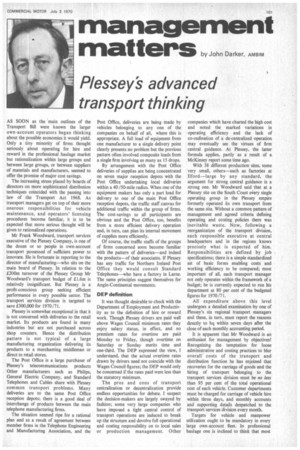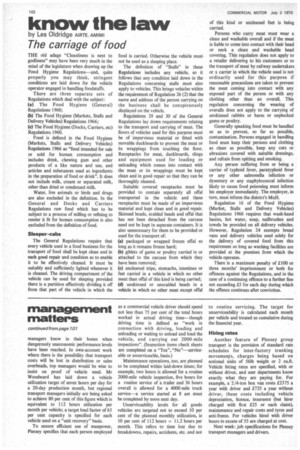management
Page 103

Page 104

If you've noticed an error in this article please click here to report it so we can fix it.
matters Dr. AMB1M
Plessey:s advanced transport thinking
AS SOON as the main outlines of the Transport Bill were known the larger own-account operators began thinking about the possible economies it would yield. Only a tiny minority of firms thought seriously about operating for hire and reward in the professional haulage market but rationalization within large groups and between large groups, or between suppliers of materials and manufacturers, seemed to offer the promise of major cost savings.
The increasing stress placed by boards of directors on more sophisticated distribution techniques coincided with the passing into law of the Transport Act 1968. As transport managers get on top of their more onerous responsibilities for vehicle maintenance, and operators' licensing procedures become familiar, it is to be expected that more serious thought will be given to rationalized operations.
Mr Frank Woodward, transport services executive of the Plessey Company, is one of the dozen or so people in own-account transport possessed of sufficient power to innovate. He is fortunate in reporting to the director of manufacturing—who sits on the main board of Plessey. In relation to the 1200m turnover of the Plessey Group Mr Woodward's transport budget of L1.6m is relatively insignificant. But Plessey is a profit-conscious group seeking efficient performance in every possible sector. The transport services division is targeted to save £300,000 for 1970/71.
Plessey is somewhat exceptional in that it is not concerned with deliveries to the retail market. Its products are found in many industries but are not purchased across shop counters. Hence the distribution pattern is not typical of a large manufacturing organization delivering its products to a merchanting middleman or direct to retail stores_ The Post Office is a large purchaser of Plessey's telecommunications products Other manufacturers such as Philips, General Electric Company, and Standard Telephones and Cables share with Plessey common transport problems. Many deliveries are to the same Post Office reception depots; there is a good deal of interchange of products between the main telephone manufacturing firms.
The situation seemed ripe for a rational plan and as a result of agreement between member firms in the Telephone Engineering and Manufacturing Association, and the Post Office, deliveries are being made by vehicles belonging to any one of the companies on behalf of all, where this is appropriate. A full load of equipment from one manufacturer to a single delivery point clearly presents no problem but the previous pattern often involved composite loads from a single firm involving as many as 15 drops.
By arrangement with the Post Office deliveries of supplies are being concentrated on seven major reception depots with the Post Office undertaking local deliveries within a 40/50-mile radius. When one of the equipment makers has only a part load for delivery to one of the main Post Office reception depots, the traffic staff canvas for additional traffic within the group of firms. the cost-savings to all participants are obvious and the Post Office, too, benefits from a more efficient delivery operation and, in turn, can plan its internal movement of supplies more efficiently.
Of course, the traffic staffs of the groups of firms concerned soon become familiar with the pattern of deliveries—and indeed the products—of their associates. If Plessey has any traffic for Northern Ireland Post Office they would consult Standard Telephones—who have a factory in Larne. The same principles suggest themselves for Anglo-Continental movements.
DEP definition It was thought desirable to check with the Department of Employment and Productivity as to the definition of hire or reward work. Though Plessey drivers are paid well above Wages Council minimum rates they enjoy salary status, in effect, and no premium rates for overtime are paid Monday to Friday, though overtime on Saturday or Sunday merits time and one-third. The DEP expressed the view, I understand, that the actual overtime rates drawn by drivers need not coincide with the Wages Council figures; the DEP would only be concerned if the rates paid were less than the statutory minimum.
The pros and cons of transport centralization or decentralization provide endless opportunities for debate. I suspect the decision-makers are largely swayed by fashion; some very large• companies who have imposed a tight central control of transport operations are induced to break up the structure and devolve full operational and costing responsibility on to local sales or production management. Other companies which have charted the high cost and noted the marked variations in operating efficiency and the lack of co-or.dination of a de-centralized operation may eventually see the virtues of firm central guidance. At Plessey, the latter formula applies, partly as a result of a McKinsey report some time ago.
With 38 different production sites, some very small, others—such as factories at Ilford—large by any standard, the argument for strong central guidance is a strong one. Mr Woodward said that at a Plessey site on the South Coast every single operating group in the Plessey empire formerly operated its own transport from the same site. Without a common pattern of management and agreed criteria defining operating and costing policies there was inevitable waste. Now, following a reorganization of the transport division, each responsible executive at central headquarters and in the regions knows precisely what is expected of him. Responsibilities are defined by job specifications; there is a simple standardized set of basic forms enabling costs and working efficiency to be compared; most important of all, each transport manager not only operates within the framework of a budget; he is currently expected to run his department at 80 per cent of the budgeted figures for 1970/71.
All expenditure above this level undergoes a detailed examination by one of Plessey's six regional transport managers and these, in turn, must report the reasons directly to hq within seven days after the close of each monthly accounting period.
It is apparent that Mr Woodward is an enthusiast for management by objectives! Recognizing the temptation for loose administrative and costing practices to blur overall costs of the transport and distribution function he has enjoined that recoveries for the carriage of goods and the hiring of transport belonging to the transport services division must be no less than 95 per cent of the total operational cost of each vehicle. Customer departments must be charged for carriage of vehicle hire within three days, and monthly accounts and supporting details despatched to the transport services division every month.
Targets for vehicle and manpower utilization ought to be mandatory in every large own-account fleet. In professional haulage one is inclined to think that most managers know in their bones when dangerously uneconomic performance levels have been reached. In own-account work where there is the possibility that transport costs will be lost in distribution or sales overheads, top managers would be wise to insist on proof of vehicle need. Mr Woodward has laid down a vehicle utilization target of seven hours per day for a 20-day production month, but regional transport managers initially are being asked to achieve 80 per cent of this figure which is equivalent to 112 hours utilization per month per vehicle; a target load factor of 65 per cent capacity is specified for each vehicle used on a "unit recovery" basis.
To ensure efficient use of manpower, Plessey specifies that each person employed as a commercial vehicle driver should spend not less than 75 per cent of the total hours worked in actual driving time—though driving time is defined as "work in connection with driving, loading and unloading or waiting to unload and load the vehicle, and carrying out 2000-mile inspections". (Inspection items check sheets are completed on a "Yes", "No"—serviceable or unserviceable, basis.) Maintenance operations, too, are planned to be completed within laid-down times; for example, two hours is allowed for a routine 2000-mile vehicle inspection, five hours for a routine service of a trailer and 36 hours overall is allowed for a 4000-mile truck service—a service started at 8 am must be completed by noon next day.
Unserviceability levels for all goods vehicles are targeted not to exceed 10 per cent of the planned monthly utilization, ie 10 per cent of 112 hours = 11.2 hours per month. This refers to time lost due to breakdowns, repairs, accidents, etc. and not to routine servicing. The target for unserviceability is calculated each month per vehicle and treated as cumulative during the financial year.
Hiring rates
Another feature of Plessey group transport is the provision of standard rate schedules for inter-factory trunking movements, charges being based on notional Units of 56Ib weight or 2 cu.ft. Vehicle hiring rates are specified, with or without driver, and user departments know exactly what they are paying for. For example, a" 2 /4-ton box van costs £2375 a year with driver and £725 a year without driver, these costs including vehicle depreciation, licence, insurance (but hirer charged with first £25 or each claim), maintenance and repair costs and tyres and anti-freeze. For vehicles hired with driver hours in excess of 55 are charged at cost.
Next week: job specifications for Plessey transport managers and drivers.




































































































































































